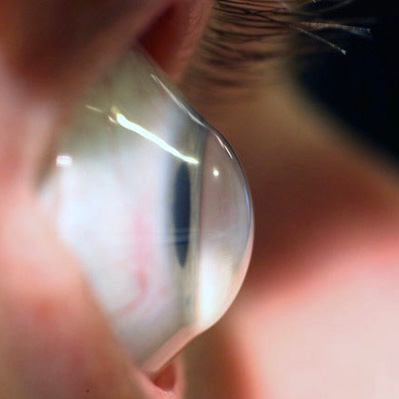Indications
Scleral lenses can be life-changing for individuals with specific eye conditions, particularly beneficial for those who struggle with traditional contact lenses due to corneal irregularities, severe dry eyes, or post-surgery complications.
These lenses offer significant relief and improved vision quality for the following conditions:
- Keratoconus:
- Irregular Corneas:
- Severe Dry Eyes:
- Post-Surgery Complications:
Helps manage vision problems caused by a cone-shaped cornea.
Ideal for eyes with irregular shapes due to surgery or disease.
Maintains a layer of moisture, reducing dryness and irritation.
Aids in cases where previous surgeries, such as LASIK and RK, result in corneal instability.
Benefits
Because of their size, scleral lenses are more stable on the eye than conventional RGP lenses, which makes them less likely to dislodge from the eye accidentally. This stability can also make them more comfortable than conventional RGP lenses; scleral lenses provide initial comfort similar to soft lenses, especially for people with sensitive eyes or irregularly shaped corneas.
Choosing scleral lenses offers several advantages that can greatly improve eye health and overall vision experience, including:
- Enhanced Comfort: The lenses vault over the cornea, minimizing irritation.
- Visual stability: Provides consistent and clear vision by maintaining their shape.
- Protection: Scleral lenses protect the cornea from environmental exposure and injuries.
- Custom Fit: Each lens is tailored to the unique shape and size of your eye.
Tips for wearers
Understanding how to properly care for and handle your scleral lenses is crucial for maintaining eye health and ensuring the best possible vision correction. Here are some key points to keep in mind:
- Proper Care: Follow your optometrist's guidelines for cleaning and storing your lenses using specific solutions designed for gas-permeable lenses to avoid contamination and ensure longevity.
- Handling Tips: Always ensure your hands are clean before handling your lenses. Avoid using tap water to rinse your lenses and instead use the recommended cleaning solution.
- Insertion and Removal: Practice the correct techniques for inserting and removing your lenses. Be gentle and patient as you become accustomed to the process.
- Hydration and Comfort: Use preservative-free saline solution to fill the lenses before insertion to maintain comfort and keep your eyes hydrated throughout the day.
- Regular Check-ups: Schedule regular visits to your eye care professional for monitoring and to ensure the lenses fit properly, detect and address any issues early on.
- Signs of Complications: Be aware of any changes in comfort, vision, or eye health. If you experience redness, pain, blurred vision, or discharge, contact your optometrist immediately.
- Lens Replacement: Follow the recommended schedule for replacing your scleral lenses to maintain their performance and comfort.

 Find out more about Keratoconus
Find out more about Keratoconus